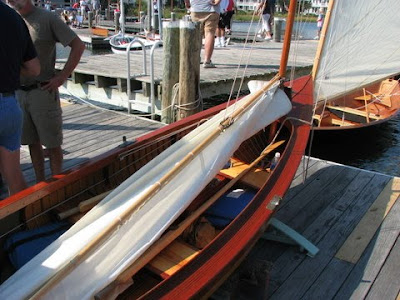
"Here is a picture of me sailing the "Rocket" Joint Venture on
the Toms River with a brother and sister. I was 12 or 13 and my Dad took the
picture fromthe dingy."

John's first boat was an A R True Rocket which his dad bought when John was 12. The carvel hull had been sheathed in glass and father and son saw to the maintenance of the boat.
the example pictured is for sale here.
 photo courtesy Barry Long, see more
photo courtesy Barry Long, see more John's most recent creation, Silent Maid, motoring into the dock for the Mid Atlantic Small Craft Festival,
basking in the late afternoon glow.

Workshop on the Water at the ISM is volunteer driven but must make it's way as a viable commercial concern.
 photo courtesy Wendy Byar, see more
photo courtesy Wendy Byar, see moreJohn at the helm during some exciting sailing on the way to St. Michaels
 courtesy John Brady
courtesy John BradyPhiladelphia high school volunteers reveling in their work, specifically this newly painted Sneakbox
 A traditional Delaware River Shad boat, synthesized from drawings and photos of older examples by John and built by the workshop. The original gillnet fishing boats would have likely had a sprit rig.
A traditional Delaware River Shad boat, synthesized from drawings and photos of older examples by John and built by the workshop. The original gillnet fishing boats would have likely had a sprit rig.
There is another version of this hull type exhibited at the Independence seaport Museum as a please touch display which details the building process.
John has built 25 to 30 boats plus some reconstructions, and has designed maybe 1o. He is committed to traditional construction and design archetypes, but not in a hidebound way, for instance, witness the Delaware River shad boat above. The original fishing boats would have had sprit rigs, but John chose to rig this example gaff. The boat was built during a period which John feels was his greatest learning experience. For seven years, the workshop on the water really was on the water, housed on a barge in the Delaware. Roger Allen was the museum director and John the lead builder. Their practice was to research, build, sail and exhibit an example of a different local boat type each year.
John also seems to have a passion for catboats, particularly the racing catboats of Barnegat Bay. His latest creation, seen above and featured elsewhere in this blog, the exquisite replica Silent Maid, he has built five of the Barnegat A cats racing today. They are Tamwock, SpyII, Spyder, Vapor and Torch. These A cats date from the same era as Silent Maid, are slightly smaller than the B cats Maid represents, very fast and very expensive to build and maintain, yet there is a spirited group of sailors enthusiastically campaigning these boats today. They are the subject of a beautiful book written and illustrated by Gary Jobson and Roy Wilkins.
I asked John what his favorite project had been and his reply was telling, ' the one in process!'. There are also frustrations, the biggest being that building in this day and age seems to pit business against craftsmanship, though John admitted this has probably been true for most wooden boat builders in any era. He feels it's nearly impossible to manage a viable business today building truly small craft, and he should know, as the WOW, though a part of the ISM, must make it's way as an viable business and relies largely on commissions and it's mostly volunteer staff, with an occasional grant. John also feels frustrated by the lack of openness on the part of most contemporary sailors to traditional ways, meaning techniques, hardware, hull and rigs, and will be campaigning the Maid in classic boat regattas, promoting the world of traditional boats and championing openness to ideas, both traditional and contemporary. I have noticed that the Maid does have some modern hardware.
When he gets around to it, John would like to build himself a 26' centerboard sloop.
Near the end of our talk I admitted to John that I was rather keen on his shad boat design and wondered if another could be built, as a youth program involving youngsters in the building and sailing as an educational program. He said he'd been mulling over the same idea for years. Now, if we could just find a sponsor...





























































2.JPG)




















